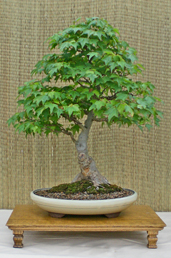Botany Basics - Part 5:
Hormones and Plant Functions
We have begun to see that plant physiology is dependent on hormones to initiate various actions that control growth functions. Auxins and gibberellin hormones react to external stimuli, light.
The Aging Process
When fruits ripen they undergo aging, or senescence, a process also directed by hormones. When leaves are prepared for abscission, separation from the stems, they also undergo the aging process. Since senescence, once begun, is irreversible, plants must posses strict control over the process to prevent the premature demise of tissues, organs or the whole plant. One of the functions of auxin, gibberellin and another hormone named cytokinin, is to inhibit senescence by maintaining the structural integrity of cells. Cytokinin is principally responsible for promoting cell divisions.
Acting against these hormones are two other growth regulators that promote the aging process. The senescence promoting substances are ethylene, a gas, and abscisic acid, so named because it is the primary agent that promotes leaf abscission.
When fruits ripen, ethylene and abscisic acid is produced and result in drastic changes that occur in cell structure, including the break down of membranes and the softening of cell walls. Leaf senescence, prior to abscission, includes the breakdown of chlorophyll and weakening of cell walls at the base of the petiole. In spring and summer, auxin produced in the leaf keep these cells intact. But, low night temperatures and short days in autumn cue the leaves to produce less auxin and increase the production of ethylene and abscisic acid. In evergreen species, sequential abscission in the oldest leaves occurs by way of the same series of biochemical events. In a like manner, abscission of fruits and flowers takes place at appropriate times.
Branching and Root Formation
We are aware that in order to make plants fill out, stem tips must be removed periodically. As long as buds are present at the stem tips, apical buds, they suppress the growth of buds, axillary buds, further back on the branch. Auxin, produced in the stem tips, exerts the inhibiting effect on axillary bud growth. Trimming a plant simply eliminates the auxin source. We are familiar with the differences between species’ abilities to form adventitious roots on cuttings. In some, root development is promoted by auxin naturally present in the cuttings. Other species must be treated with a rooting compound, a preparation of synthetic auxin.
In early research on growth regulators, it was speculated that each process was controlled by a different hormone. It soon became apparent that only a few hormones, either individually or in combination with each other regulate these many processes.
In addition to the roles played by the five hormones described, the following may be added. Gibberellins control seed germination; ethylene promotes stem thickening, especially in seedlings; abscisic acid brings on dormancy where gibberellin revives them from winters sleep. Each passing day, plant physiologists learn more of the interplay between hormones and plant functions. Yet, there are more questions than answers in this great mystery of how plants function.
The search for plant growth regulators, first started as a subject of academic interest, has grown into a multimillion dollar business. Plant physiologists have discovered several chemical compounds not produced by plants which regulate growth when introduced into certain plant species. Some are becoming increasingly useful in agriculture and horticulture, some of which are; defoliants, disbudders, growth retarders, fruit setters and herbicides. This industry has helped finance the research into plant physiology, enhancing our knowledge of how plants function.
Please click on one of the links below:

